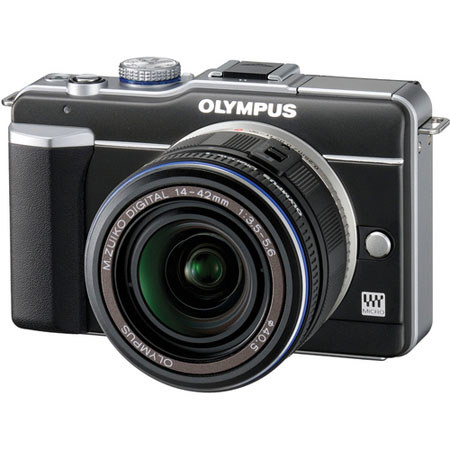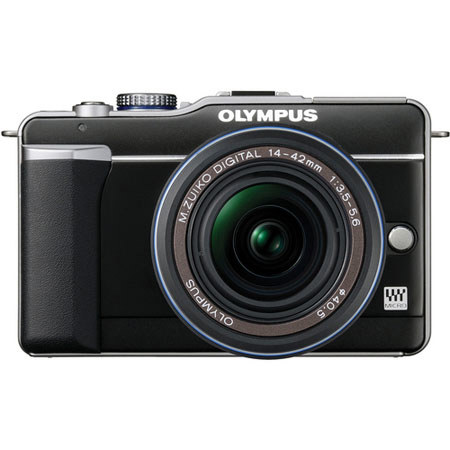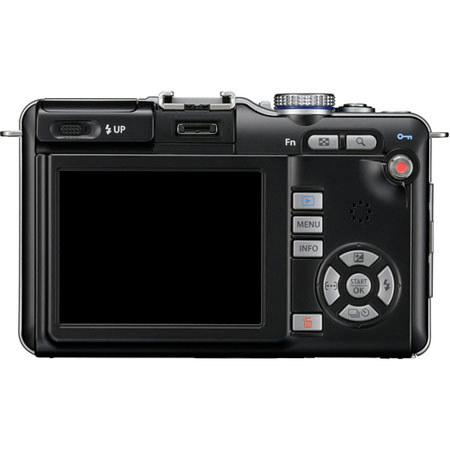Automate EverythingLive Guide is just the start of automated technologies on the E-PL1 designed to free you up to focus on your subjects instead of focusing on your camera's settings.
- 19 Scene-Select Modes: From portraits to sunset shots, the E-PL1 is equipped with 19 Scene-Select modes for effortless picture taking, including Fireworks, Sunset, Children, Macro and Panorama, to name a few. Capturing beautiful portraits is easy with the ePortrait Mode that enables you to smooth your subject's complexion.
- Intelligent Auto (iAuto) Mode: When you don't want to use the scene-select modes, the iAuto mode automatically identifies what you're shooting and adjusts settings for you to capture the best result depending on the situation.
- Face Detection: Reduce the chance of blurred subjects in images by recognizing up to eight faces, tracking them within the image area, and automatically focusing and optimizing exposure for sharp portraits.
- In-Camera Panorama: Capture three images and stitch them together to create one amazing, seamless panoramic picture. Or use the included OLYMPUS [ib] software to stitch up to 10 images together for the ultimate panorama.
- iEnhance: With this mode the warm yellow and orange colors of a sunset are heightened to a dramatically lifelike color that's truer to what you see with the naked eye. iEnhance can be used in any mode, and automatically engages when using iAuto to enrich color in any subject.
- Share: Just connect the camera to an HDTV with an optional HDMI cable and use your TV remote to control playback functions and navigate the camera's menus from the comfort of your personal front-row seat. The E-PL1 records to SDHC (Class 6 recommended) media cards that can be plugged directly into many devices and accommodate large files, including videos.
 |


Stabilize All of Your Lenses
Instead of selling more expensive lenses that have image stabilization inside them, Olympus takes a different approach by having image stabilization built right into the body of the E-PL1. This means that any lens (Micro Four Thirds, Four Thirds and any third-party lens) attached to the E-PL1 will deliver blur-free images thanks to three modes of In-body Image Stabilization that automatically compensate for camera shake, including in low-light situations or when shooting without a tripod. Since the PEN cameras are the world's smallest interchangeable-lens cameras with image stabilization built inside the body, you can take the E-PL1 with you and capture great images, and it won't weigh you down.


Ref user comment amazon:
A Nice Camera But A Bit of A Mixed Bag,
By
This
review is from: Olympus PEN E-PL1 12.3MP Live MOS Micro Four Thirds
Interchangeable Lens Digital Camera with 14-42mm f/3.5-5.6 Zuiko Digital Zoom
Lens (Black) (Electronics)
What do you get when you take Olympus PEN
and mix it with a stripper (Of course I mean someone who strips features from a
camera). You get the E-PL1 camera which is a little bit of a mixed bag. On the
one hand you have one of the best versions of the m4/3 sensor to date. From what
I have read it is better than both the E-P1 and E-P2 sensors. It is hard to tell
the difference at normal screen and printing resolutions and I take a picture at
its whole and don't pixel peep so I cannot verify that. What I can say is this
camera is capable of producing world class images. Additionally, this camera has
the Olympus JPEG engine which is regarded in the business as one of the best.
This camera is also relatively small and light and includes a fill flash.
Additionally, it has image stabilization (IS) built into the camera. It is not
pocketable and the size of this camera has more to do with the lens that it is
wearing then the actual camera itself.On the other hand, you have a camera that is slow to focus. It appears to me that it zooms to infinity (and beyond) and then catches the focus on its way back in. If you are taking pictures of forever-in-motion kids you can be sure you will miss quite a few decisive moments. Additionally, this camera lacks the most important camera control there is. This is the control wheel used to change exposure, aperture, and shutter settings in a quick efficient manner. Instead this camera uses buttons which is an unwieldy way of making these changes. Most higher end Point and Shoot (P+S) cameras have some version of this control wheel. I think anyone transitioning to this camera from a DSLR or high end P+S will be frustrated by this. I've seen this billed as a good thing as there are less controls to get confused over. That may be so but all m4/3 cameras can be used as point and shoot by just keeping in the intelligent Auto(iA) mode. This simplifies the menu options and takes great pictures a majority of the time.
I think for anyone who wants to step up from a P+S to take better Image Quality pictures but plans to stay in the iA mode 90% of the time, then this camera will serve you well and will take some amazing images. Just remember P+S type focusing speed.
Anyone, who has a E-P1or E-P2 who want a sensors with a weaker Anti-Aliasing filter (i.e. less detail lost to the AA filter) and a fill flash will enjoy this camera for the IQ but will probably be frustrated with the loss of the control wheel
Anyone either stepping up from a high end P+S such as the LX3, S90, or G11 will be impressed with the images, but not blown away by the difference, unimpressed with the P+S focus performance, and frustrated in the P, A, S or M shooting modes. Additionally, you will be unimpressed with the bigger size of the camera but will enjoy the flexibility if your budget includes other lenses.
Anyone, getting this as a second carry around camera to a DSLR, will be happy with the smaller size and weight but unhappy with the slower performance. And frustrated by the clumsy controls but happy with the video capabilities.
If you don't need or want the video, don't mind IS in the lens instead of the camera, and can put up with a slight decrease in you IQ, ISO, and JPEG performance, then the Panasonic Lumix DMC-G1 12.1MP Digital Camera with Lumix G Vario 14-45 mm f/3.5-5.6 ASPH Mega OIS Lens (Red) offers many upgrades at the same price (Integrated 1.4mp EVF, Swivel Screen, 460k screen, Grip for bigger lenses, faster focus performance, etc)
For the same price, the newly announced G10 matches the E-PL1 with video, and new processing engine (cross your fingers for a JPEG improvement). Additionally, it has a 2kp EVF (I'm not sure how useful that will be), a grip, a control wheel, a 1/4000 shutter speed and faster focus performance. It does not have in-camera IS.
For those planning on getting the EVF at some point or with an ~$200 greater budget, check out the newly announced G2. Take the G1, add 720P 60/50fps video, an improved processing engine, a new dial to change focusing modes, touch screen controls that look to work as slick as an iPhone, and touch screen focus, and you have a really really nice full featured camera.
Finally, if you don't need interchangeable lenses or don't plan on buying any more lenses and you don't mind a degradation of IQ, then the Canon S90, Canon G11, and Panasonic LX3(Leica D-Lux 4) are easier to carry around everywhere (especially the S90) and are cheaper(the gap will close when the price of this camera falls).
Here is a quick list of pros and cons of the E-PL1
Pros
The best Olympus implementation of the m4/3 sensor
One of the best JPEG engines in the business
Relatively small and light
Built in flash
In camera Image Stabilization(IS)
Price (The cheapest m4/3 yet)
Optional EVF (A very nice 1.4mp unit but very pricy at $279)
Its available
Nice build quality
Cons
Slow Autofocus (Panasonic has this figured out. Olympus, not so much)
Missing Control Wheel slows down aperture, shutter, and exposure changes
Only 230k screen?!
1/2000 shutter speed?! A lot of P+S go to 1/4000
Locking lens is annoying to deploy and stow
Overall
A competent and nice camera that will take stunning images. Slow autofocus and clunky controls will make this camera frustrating to many people.
Ingen kommentarer:
Legg inn en kommentar